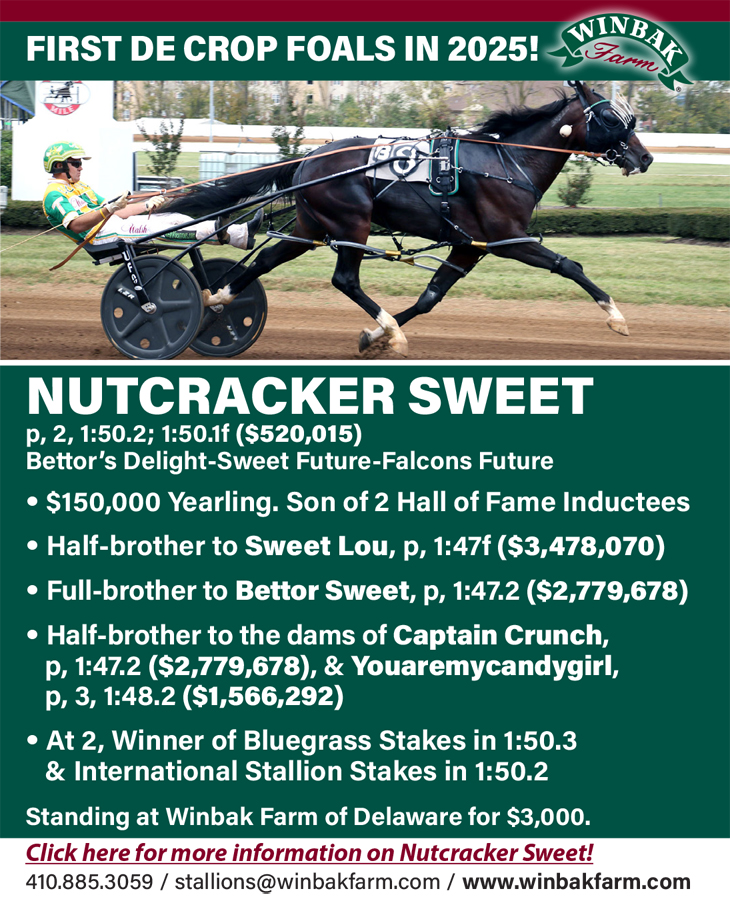
Detailing Campbell’s record six Hambletonian wins… and the one that got away
The Hall of Fame driver recounts his triumphs in America’s biggest harness race.
by Dave Briggs
John Campbell remembers the exact moment he knew his last real chance to win the Hambletonian had slipped from his grasp. Mere steps from the wire in the 2014 Hambletonian, his charge Nuncio was passed by stablemate Trixton driven by trainer Jimmy Takter.
“Going around the turn after the wire I thought to myself, ‘I’m not going to get that many more opportunities like this,’” Campbell said. “It was a disappointment in that way.
“Nuncio raced so well and got beat [by a half-length]… so that was really a disappointing loss just because he lost, not in his effort. The horse raced tremendous. I thought the race he went, he deserved to win, but that’s racing. It isn’t fair.”
Despite winning a record six Hambletonians as a driver, the competitive fire was still white hot in Campbell in 2014 despite the fact he was in the twilight of his career. He retired from racing three years later, but not before setting a Hambletonian record that is going to be awfully tough for another driver to top.
Today, Campbell is the chief steward of the race as the CEO of the Hambletonian Society.
But this week we asked him to put his famed white, maroon and blue colours back on for a drive down Hambletonian memory lane.
It took Campbell five years of trying to win his first Hambletonian, but when that first victory finally came in 1987, it was with the trotter he has consistently called the single greatest horse he has ever driven — Mack Lobell.
“He was going in in good shape,” Campbell said of Mack Lobell. “He came back really good as a 3-year-old. I’d never won [the Hambletonian], so there was always that apprehension for a race you hadn’t won yet.
“I had all the confidence in the world in him going in, but that day, his feet were bothering him. It was a hot day and the track was a little firmer than he would like. [Trainer Chuck Sylvester] changed his shoes in between the first and second heat. Obviously, everybody remembers him going off-stride right at the wire, or right after the wire, but it didn’t matter at that point. That was just a product of his feet bothering him that day and he just said, ‘This is as far as I’m going.’
“It showed how much grit and how much he would go through because he won by open lengths and was under pretty intense pressure from the start to the three-eighths before I could give him a breather.
“It was a big relief when it was over, put it that way, to finally win the Hambletonian. And just the satisfaction as well.”
His second Hambletonian came the next year with Armbro Goal.
“I just fell into that drive because that was Berndt Lindstedt’s drive and he was trained by Jan Johnson,” Campbell said. “They also had Supergill and their owner wanted to line up a driver for the elimination and the final, so they called me and it was an easy decision to say yes. Armbro Goal was in good form at the time and he was exceptional that day. He won easily and I really didn’t have a lot to do other than keep him out of trouble.”
It was just two years later when Campbell won the 1990 Hambletonian with Harmonious.
“He just raced in overnight races prior to the Hambletonian,” Campbell said. “Osvaldo Formia was training for Lindy Farms and I was under strict instruction in all of those overnights, ‘Don’t race him hard. Make sure he’s covered up, make sure he finishes strong.’ For a couple of those, he was a pretty big favorite and I thought we should be going forward and it was an absolute ‘no’ on that and they were pointing him to the Hambletonian.
“He just kept getting stronger and stronger in those overnight races and on Hambletonian Day he actually had to come first over in his elimination, but I didn’t have to use him hard until the end of the stretch and he gave me a real good run. Then, in the final, he got a good trip. He was second over right into the stretch and he won, but that was a horse that was pointed directly for the Hambletonian and it was a plan that paid off perfectly.”
In 1995, Campbell won the Hambletonian with his brother Jim Campbell’s trainee Tagliabue.
“He was a green horse,” John said. “Again, it was good fortune that I got to drive him. That was the year of Donerail and he had a fantastic 2-year-old season and was 2-year-old of the year and had come back and I was committed to drive Donerail until he was done racing. It was a relationship I had with Mr. Suslow that I would drive him no matter what.
“Then, he didn’t come back well at 3. I raced Tagliabue in the Dancer and he came from way back to be second and he raced extremely well and I told Jim, ‘He’s going into the Hambletonian in really good shape, but I can’t drive him because I’ve got Donerail that I’ve committed to.’ He said, ‘Okay.’ Then, before the draw came out, they retired Donerail and Stanley [Dancer] wasn’t comfortable with him and just didn’t think he was going to race up to the standards he had set as a 2-year-old, so I immediately got on the phone with Jim and said I could drive that horse, so that worked out pretty good for Jim and me and our whole family.
“A lot of people don’t remember, but [Tagliabue] made a break in his elimination. He was getting a good trip. I hadn’t even asked him, he was just sitting there and he went on a break… my first thought was, ‘Get out of the way, before I interfere with somebody,’ so I just looked over my shoulder to get clearance to move out of the way and when I looked back he was trotting.
“Some people said to me, ‘What a great job you did, getting him back trotting.’ I didn’t do anything. All I did was look over to make sure I wasn’t going to run into somebody and when I looked back, he was trotting.”
In 1998, John teamed up again with Sylvester to win the Hambletonian, this time with Muscles Yankee.
“Muscles Yankee had shown signs as a 2-year-old of being a top horse,” John said. “He didn’t really get started until later in the summer of his 2-year-old year. He made breaks – he just got two wound up in the Valley Victory at Garden State the end of his 2-year-old year.
“When Chuckie brought him back, his manners were impeccable. I could do whatever I wanted with him, whenever I wanted. We, obviously, had the Hambletonian on our minds from the time he qualified and he kept his form from the time he qualified through the Hambletonian. He was really, really strong. I just thought going in that, as long as I keep him out of trouble, he was going to be hard to beat.
“When they settled down the backstretch and the pace slowed, there was an opportunity to go back to the front and I just didn’t think he could lose if that were the case and he proved me right.
“Muscles Yankee had a club foot, which was something Chuck had to deal with throughout his career… but I never had a problem with it from a driver’s standpoint. He never showed me anything in a race that it ever bothered him, but I know it did.”
Muscles Yankee’s impact off the track may have been even greater. He is the sire of Muscle Hill, the horse many say is the greatest trotter of all time.
“Muscles Yankee certainly left his mark on the industry,” John said. “He had a big impact, both on the track and off.”
It would be eight more years until John won another Hambletonian and the 2006 victory with Glidemaster turned out to be the driver’s last win in the race.
“I got hurt and broke my arm in 2003 and it was a couple of years getting back to where I was before from a business standpoint, client standpoint,” John said. “In 2006, everything was going quite well then, but when I got the chance to drive [Glidemaster]… he was very difficult to hold. You had to be so careful. He wasn’t a horse that wanted to race on the front, he was much better off the pace.
“I told [trainer] Blair [Burgess], the first time I drove him, ‘You’ve got to get him, so I can drive him like [Burgess trainee] Real Desire.’ Real Desire was so handy and he was better off the pace as well.
“Blair started fooling with [Glidemaster’s] equipment and he got him so that by Hambletonian time I could drive him relatively easy. He had a foot problem the week of the elimination and Blair wasn’t even sure he could get him raced. He did and we got him qualified and finished second and then he had the extra week to work on that foot and he was exceptional.
“He was back in the early part, but the outer flow moved up and the fractions were fairly stiff. Going around the last turn, I was just loaded and I was sure when I moved him that he was just going to trot right by them and he sure did.
“It was a little overlooked, but who raced really well in that race was Chocolatier. He had the 10-hole and finished second and was still coming at the wire.”
Of the drivers still active, Scott Zeron is closest to John’s Hambletonian record of six victories. Zeron has won the race three times.
“I’d never go so far as to say someone would never reach that or surpass it, but it’s something certainly that I’m very proud of,” John said of his six triumphs in the 19 years between 1987 and 2006.
“It’s our biggest race, our most world-renowned race and the fact that I’ve won it more than anyone else, that’s something I’m very proud of.”













